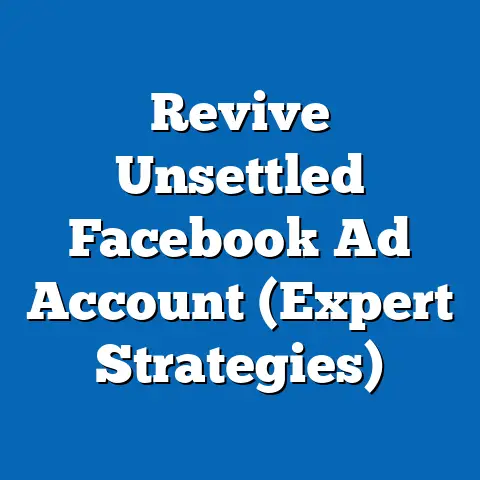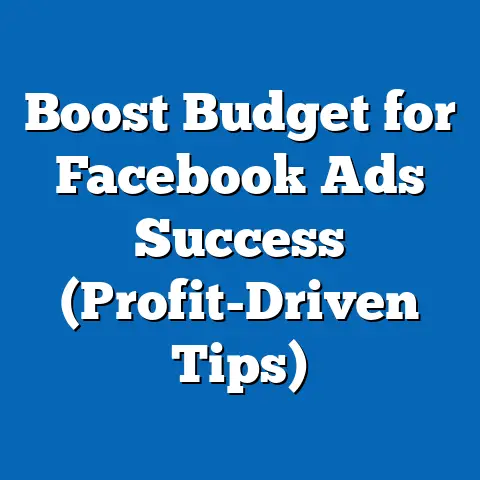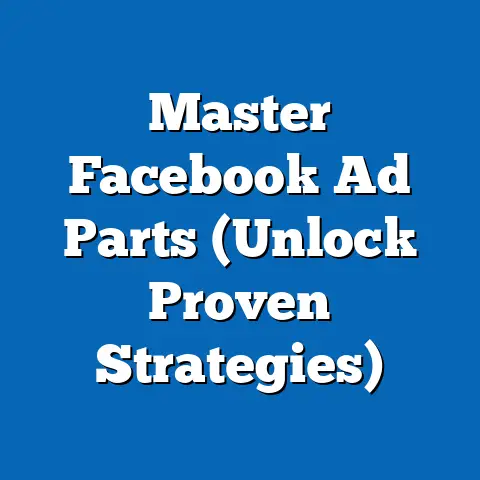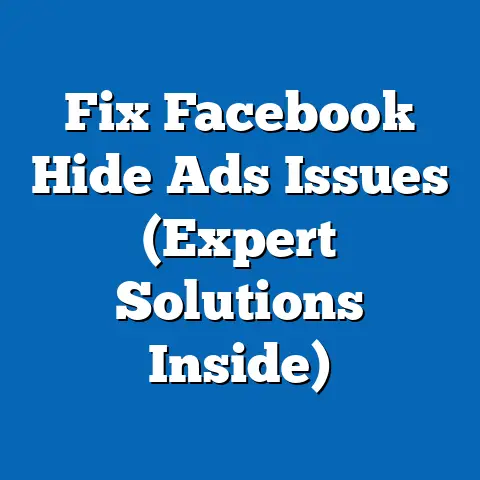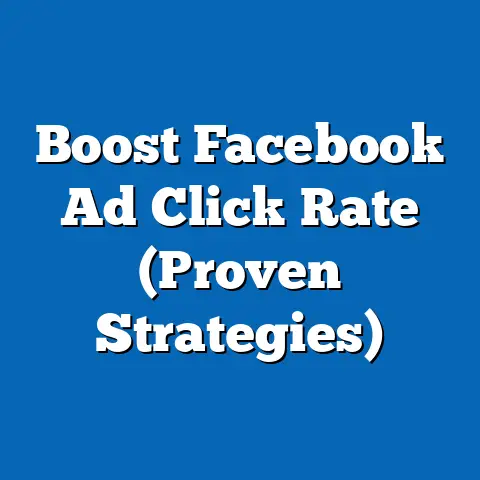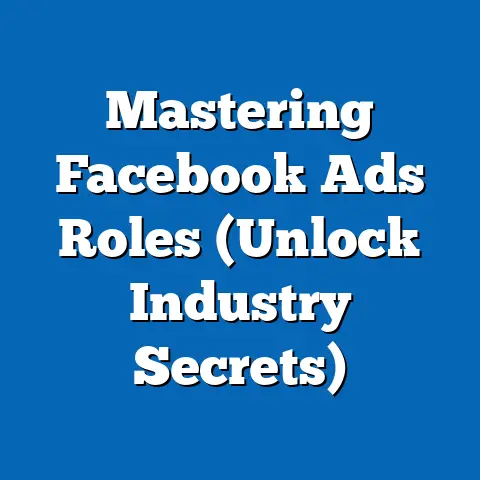Elevate Ads: Transform Apps to Facebook Pages (Pro Tips)
Have you ever poured your heart and soul into creating an amazing app, only to watch it languish in the app store abyss, untouched and undiscovered? It’s a feeling I know all too well. In today’s fiercely competitive digital world, simply having a great app isn’t enough. You need a strategy, a megaphone, and a way to connect with your potential users on a personal level. That’s where Facebook Pages come in.
For years, I struggled with getting my own apps noticed. I tried everything from traditional app store optimization (ASO) to running expensive ad campaigns that yielded little return. Then, I discovered the power of leveraging Facebook Pages. It wasn’t just about another marketing channel; it was about building a community, fostering engagement, and driving genuine interest in my creations.
This article isn’t just another “how-to” guide. It’s a culmination of my experiences, my successes, and my mistakes. I’m going to share with you the pro tips I’ve learned along the way to help you transform your app into a thriving Facebook Page, elevate your ads, and finally get the recognition your app deserves.
The Importance of Facebook Pages for Apps
Let’s be honest, the app store is a crowded place. Millions of apps are vying for attention, and getting yours to stand out feels like finding a needle in a haystack. That’s where Facebook Pages can be a game-changer.
Why Facebook Pages Matter
- Reach: Facebook boasts billions of active users worldwide. A well-managed Facebook Page gives you access to a massive audience, far exceeding what you can typically achieve through app store search alone.
- User Engagement: Unlike app store listings, Facebook Pages encourage two-way communication. You can interact with users, answer their questions, gather feedback, and build a loyal community around your app.
- Branding: Your Facebook Page is an extension of your app’s brand. It allows you to showcase your app’s personality, values, and unique selling propositions in a way that resonates with your target audience.
Statistics That Speak Volumes
Consider these compelling statistics:
- As of Q4 2023, Facebook reported 3.07 billion monthly active users (MAUs), making it the most popular social media platform globally (Source: Statista). This provides an unparalleled potential reach for app promotion.
- According to a study by Hootsuite, Facebook ads reach 31.2% of the world’s population aged 13 and older. This illustrates the platform’s broad advertising capabilities.
- A survey by Social Media Examiner found that 66% of marketers use Facebook for lead generation, highlighting its effectiveness in driving conversions.
These numbers aren’t just abstract figures; they represent real people, potential users, and untapped opportunities for your app.
Real-World Success Stories
Take, for example, the mobile game “Gardenscapes.” While initially relying on app store advertising, the developers at Playrix invested heavily in their Facebook Page. They regularly posted engaging content, ran contests, and even created personalized ads based on user interests. The result? A massive surge in downloads, a thriving community of players, and a significant boost in revenue.
Another example is the language learning app, Duolingo. They use their Facebook Page to share language tips, cultural insights, and user success stories. This not only promotes their app but also creates a sense of community and encourages users to stay engaged with their platform.
Takeaway: Facebook Pages are not just a nice-to-have; they’re an essential tool for app promotion in today’s digital landscape. They offer unparalleled reach, engagement opportunities, and branding potential.
Understanding the Transition Process
Transforming your app into a Facebook Page isn’t just about creating a profile and posting a few updates. It’s a strategic process that requires careful planning and execution.
Defining Your Objectives
Before you even create your Page, ask yourself: What do I want to achieve?
- Increase Visibility: Are you looking to expand your app’s reach beyond the app store?
- Build Community: Do you want to create a space where users can connect, share feedback, and support each other?
- Drive Downloads: Is your primary goal to increase the number of people downloading your app?
Your objectives will guide your content strategy, ad campaigns, and overall approach to managing your Facebook Page. For me, the initial goal was always to increase downloads, but I quickly realized that building a community was just as important for long-term success.
Technical Steps: A Quick Overview
While the specifics will depend on your app and your technical expertise, here’s a general outline of the technical steps involved:
- Create a Facebook Page: This is the most basic step. Choose a relevant category for your app (e.g., “App Page,” “Gaming App,” “Education App”).
- Link Your App: Integrate your app with your Facebook Page using the Facebook SDK (Software Development Kit). This allows you to track installs, engagement, and other key metrics.
- Set Up App Events: Define custom app events that you want to track (e.g., “App Launched,” “Level Completed,” “In-App Purchase”). This data will be invaluable for optimizing your ad campaigns.
- Configure Deep Linking: Implement deep linking so that users who click on your Facebook ads are taken directly to the relevant section of your app.
- Add a Call-to-Action Button: Use the call-to-action button on your Facebook Page to encourage users to download your app. Options include “Download,” “Use App,” or “Play Game.”
Takeaway: The transition process involves defining your objectives and taking the necessary technical steps to integrate your app with your Facebook Page. This integration allows you to track performance, optimize your campaigns, and drive meaningful results.
Pro Tips for Elevating Your Ads
Now that you have a basic understanding of the importance and process of creating a Facebook Page for your app, let’s dive into the pro tips that will help you elevate your ads and achieve your marketing goals.
Tip 1: Optimize Your Page Content
Your Facebook Page is your app’s digital storefront. It’s the first impression many potential users will have, so make it count.
- Compelling Page Description: Craft a concise and engaging description that highlights your app’s key features, benefits, and target audience. Use keywords that people are likely to search for.
- High-Quality Visuals: Use eye-catching images and videos that showcase your app’s user interface, features, and gameplay. Invest in professional-quality graphics to make a lasting impression.
- Brand Consistency: Ensure that your Facebook Page’s branding aligns with your app’s overall brand identity. Use the same colors, fonts, and tone of voice across all your marketing materials.
I once made the mistake of using generic stock photos on my Facebook Page. It wasn’t until I replaced them with screenshots and videos of my app that I started seeing a significant increase in engagement.
Tip 2: Leverage Facebook Ads
Facebook Ads are a powerful tool for driving traffic to your Facebook Page and, ultimately, to your app.
- Targeted Ad Campaigns: Use Facebook’s advanced targeting options to reach the right audience for your app. Target users based on their interests, demographics, behaviors, and even their mobile device usage.
- Budget Allocation: Experiment with different budget levels to find the sweet spot that delivers the best results for your app. Consider using a daily budget or a lifetime budget, depending on your goals and resources.
- Effective Ad Formats: Test different ad formats to see what resonates best with your target audience. Video ads, carousel ads, and collection ads can all be effective for promoting apps.
One of the most effective ad campaigns I ever ran involved creating a video ad that showcased the unique features of my app. I targeted users who were interested in similar apps and used a compelling call-to-action to encourage them to download my app.
Tip 3: Engage with Your Audience
Building a community around your app is crucial for long-term success.
- Regular Updates: Post regular updates about your app, including new features, bug fixes, and upcoming events. Keep your audience informed and engaged.
- Respond to Comments: Respond to comments and messages promptly and professionally. Show your audience that you care about their feedback and are willing to address their concerns.
- Facebook Live Sessions: Host Facebook Live sessions to interact with your audience in real-time. Answer their questions, demonstrate your app’s features, and build a personal connection.
I remember hosting a Facebook Live session where I answered user questions about my app. It was a great way to connect with my audience on a personal level and build trust.
Tip 4: Use Facebook Insights for Optimization
Facebook Insights provides valuable data about your audience, your content, and your ad performance.
- Track Engagement Metrics: Monitor metrics such as likes, comments, shares, and click-through rates to see what content resonates best with your audience.
- Analyze User Demographics: Use Facebook Insights to understand the demographics of your audience, including their age, gender, location, and interests.
- Refine Your Strategies: Use the data you gather from Facebook Insights to refine your content strategy, ad campaigns, and overall approach to managing your Facebook Page.
I regularly use Facebook Insights to track the performance of my ads and content. This data helps me to identify what’s working and what’s not, so I can make informed decisions about how to optimize my campaigns.
Tip 5: Collaborate with Influencers
Influencer marketing can be a powerful way to extend your reach and build credibility.
- Identify Suitable Partners: Look for influencers who have a relevant audience and a strong reputation in your niche.
- Approach Collaborations: Reach out to influencers and propose a collaboration that benefits both parties. Offer them a free copy of your app, a commission on downloads, or other incentives.
- Extend Reach and Credibility: Partner with influencers or other brands to extend your reach and credibility. Provide tips on how to identify suitable partners and approach collaborations.
I once partnered with a popular tech blogger to review my app. His review not only drove a significant amount of traffic to my Facebook Page but also helped to build trust and credibility with my target audience.
Takeaway: Elevating your ads requires a multifaceted approach that includes optimizing your page content, leveraging Facebook Ads, engaging with your audience, using Facebook Insights for optimization, and collaborating with influencers.
Common Pitfalls to Avoid
Even with the best strategies, there are common pitfalls that can derail your efforts. Here are some mistakes I’ve made (and seen others make) and how to avoid them.
- Neglecting User Engagement: Failing to respond to comments, questions, or feedback can make your audience feel ignored and undervalued.
- Solution: Dedicate time each day to engage with your audience. Respond to comments promptly, answer questions thoroughly, and address concerns professionally.
- Inconsistent Content Updates: Posting sporadically or failing to update your content regularly can make your Page look outdated and inactive.
- Solution: Create a content calendar and stick to it. Plan your posts in advance and schedule them using Facebook’s built-in scheduling tool.
- Ignoring Facebook Insights: Failing to track your metrics and analyze your data can leave you in the dark about what’s working and what’s not.
- Solution: Regularly review your Facebook Insights data and use it to inform your content strategy, ad campaigns, and overall approach to managing your Page.
- Using Generic Ad Copy: Using the same generic ad copy for all your campaigns can result in low click-through rates and poor performance.
- Solution: Tailor your ad copy to your target audience. Use compelling language that speaks to their needs and interests.
- Not Testing Different Ad Formats: Sticking to the same ad format can limit your reach and prevent you from discovering more effective options.
- Solution: Experiment with different ad formats, such as video ads, carousel ads, and collection ads, to see what resonates best with your target audience.
- Solution: Dedicate time each day to engage with your audience. Respond to comments promptly, answer questions thoroughly, and address concerns professionally.
- Solution: Create a content calendar and stick to it. Plan your posts in advance and schedule them using Facebook’s built-in scheduling tool.
- Solution: Regularly review your Facebook Insights data and use it to inform your content strategy, ad campaigns, and overall approach to managing your Page.
- Solution: Tailor your ad copy to your target audience. Use compelling language that speaks to their needs and interests.
- Solution: Experiment with different ad formats, such as video ads, carousel ads, and collection ads, to see what resonates best with your target audience.
I learned the hard way about the importance of consistent content updates. I went through a period where I was too busy to post regularly, and my engagement plummeted. It took me a while to recover and rebuild my audience.
Takeaway: Avoiding these common pitfalls requires diligence, attention to detail, and a willingness to learn from your mistakes.
Measuring Success
How do you know if your Facebook Page is actually contributing to your app’s success? The answer lies in tracking the right Key Performance Indicators (KPIs).
- Engagement Rates: Measure the percentage of users who interact with your content (e.g., likes, comments, shares). High engagement rates indicate that your content is resonating with your audience.
- Conversion Rates: Track the percentage of users who click on your call-to-action button and download your app. High conversion rates indicate that your ad campaigns are effective.
- App Downloads: Monitor the number of app downloads that can be attributed to your Facebook Page. This is the ultimate measure of success.
- Website Traffic: Track the amount of traffic that your Facebook Page is driving to your app’s website. This can be a good indicator of brand awareness and interest.
- Return on Ad Spend (ROAS): Calculate the return on investment for your Facebook ad campaigns. This will help you to determine whether your ad spend is generating a positive return.
Remember, success isn’t just about immediate downloads. It’s about building a loyal community that supports your app over the long term.
Long-Term Strategies
Building a successful Facebook Page is an ongoing process. It requires a long-term strategy that includes:
- Content Calendar: Plan your content in advance and schedule it using Facebook’s built-in scheduling tool.
- Ongoing Ad Campaigns: Continuously run ad campaigns to drive traffic to your Page and promote your app.
- Community Management: Dedicate time each day to engage with your audience and build relationships.
- Data Analysis: Regularly review your Facebook Insights data and use it to inform your strategies.
Takeaway: Measuring success requires tracking the right KPIs and implementing a long-term strategy that includes content planning, ongoing ad campaigns, community management, and data analysis.
Conclusion
Transforming your app into a thriving Facebook Page is not just a marketing tactic; it’s a strategic imperative in today’s competitive digital landscape. By understanding the importance of Facebook Pages, mastering the transition process, leveraging pro tips, avoiding common pitfalls, and measuring your success, you can elevate your ads, build a loyal community, and finally get the recognition your app deserves.
I know it can seem daunting, but trust me, the effort is worth it. With the right approach, you can unlock the full potential of Facebook Pages and take your app to the next level. So, take action today, implement these pro tips, and watch your app soar!

